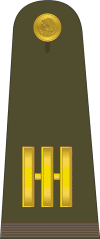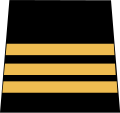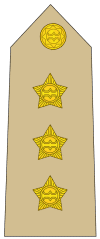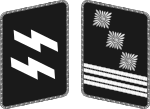Captain (armed forces)
The army rank of captain (from the French capitaine) is a commissioned officer rank historically corresponding to the command of a company of soldiers. The rank is also used by some air forces and marine forces. Today, a captain is typically either the commander or second-in-command of a company or artillery battery (or United States Army cavalry troop or Commonwealth squadron). In the Chinese People's Liberation Army, a captain may also command a company, or be the second-in-command of a battalion.
In NATO countries, the rank of captain is described by the code OF-2 and is one rank above an OF-1 (lieutenant or first lieutenant) and one below an OF-3 (major or commandant). The rank of captain is generally considered to be the highest rank a soldier can achieve while remaining in the field.
In some militaries, such as United States Army and Air Force and the British Army, captain is the entry-level rank for officer candidates possessing a professional degree, namely, most medical professionals (doctors, pharmacists, dentists) and lawyers. In the U.S.. Army, lawyers who are not already officers at captain rank or above enter as lieutenants during training, and are promoted to the rank of captain after completion of their training if they are in the active component, or after a certain amount of time, usually one year from their date of commission as a lieutenant, for the reserve components.
The rank of captain should not be confused with the naval rank of captain or with the UK-influenced air force rank of group captain, both of which are equivalent to the army rank of colonel.
History
The term ultimately goes back to Late Latin capitaneus meaning "chief, prominent"; in Middle English adopted as capitayn in the 14th century, from Old French capitaine.
The military rank of captain was in use from the 1560s, referring to an officer who commands a company. The naval sense, an officer who commands a man-of-war, is somewhat earlier, from the 1550s, later extended in meaning to "master or commander of any kind of vessel". A captain in the period prior to the professionalization of the armed services of European nations subsequent to the French Revolution, during the early modern period, was a nobleman who purchased the right to head a company from the previous holder of that right. He would in turn receive money from another nobleman to serve as his lieutenant. The funding to provide for the troops came from the monarch or his government; the captain had to be responsible for it. If he was not, or was otherwise court-martialed, he would be dismissed ("cashiered"), and the monarch would receive money from another nobleman to command the company. Otherwise, the only pension for the captain was selling the right to another nobleman when he was ready to retire.
Air forces
Many air forces, such as the United States Air Force, use a rank structure and insignia similar to those of the army.
However, the United Kingdom's Royal Air Force, many other Commonwealth air forces and a few non-Commonwealth air forces[1] use an air force-specific rank structure in which flight lieutenant is OF-2. A group captain is OF-5 and was derived from the naval rank of captain.
In the unified system of the Canadian Forces, the air force rank titles are pearl grey and increase from OF-1 to OF-5 in half strip increments.[2]
Equivalent captain ranks
| Rank name | Country name |
|---|---|
| Kapitani | Georgia |
| Akhmad | Mongolia |
| Capitaine | France and most Armed forces modelled after the French Armed Forces |
| Canada (Fr.) | |
| Belgium (Fr.) | |
| Switzerland (Fr.) | |
| Capitano | Italy |
| Capitán | Spain |
| Capitão | Brazil |
| Capitão | Portugal |
| Căpitan | Romania |
| Hauptmann | Austria |
| Germany | |
| Switzerland (De.) | |
| Hauptsturmführer | Waffen-SS |
| Jeg-tooran (جګتورن) | Afghanistan |
| "Kapitán", Capitán, Captain | Philippines |
| Kapetan (Капетан) | Bosnia, Serbia, North Macedonia |
| Kapitan (Капитан) | Russia |
| Kapitan | Ukraine |
| Kapitan | Poland |
| Kapitan | Azerbaijan |
| Kapitan (Капитан) | Bulgaria |
| Kapitan (Капітан) | Ukraine |
| Kapitein | Netherlands |
| Belgium (Nl.) | |
| Kapteinis | Latvia |
| Kapitonas | Lithuania |
| Kapitán | Czech Rep. |
| Kapitán | Slovakia |
| Kaptajn | Denmark |
| Kaptan (کپتان) | Pakistan |
| Kapteeni | Finland |
| Kaptein | Norway |
| Kapten | Indonesia/Malaysia |
| Kapten | Sweden |
| Lochagos (Λοχαγός) | Greece |
| Bo Gyi (ဗိုလ်ကြီး) | Myanmar |
| Phu Kong (ผู้กอง) | Thailand |
| Roi Ek (ร้อยเอก) | Thailand |
| Satnik | Croatia |
| Stotnik | Slovenia |
| Seren (סרן) | Israel |
| Shangwei (上尉), | China |
| Shangwei (上尉), | Taiwan |
| Százados | Hungary |
| Taewi (대위) | South Korea |
| Taii (大尉), Ichii (一尉) | Japan |
| Yüzbaşı | Turkey |
| Đại Úy | Vietnam |
Insignia
A variety of images illustrative of different forces' insignia for captain (or captain-equivalents) are shown below:

Argentine Army
(Capitán)




Brazilian Army
(Capitão)
Brazilian Air Force
(Capitão)Brazilian Military Police
(Capitão)
-2014.svg.png)

Colombian Army 

Kapitán
Czech Republic Army



Kapteeni
Finnish Defence ForceCapitaine
French Army
Capitaine des Eaux et Forêts
French Forests Office
კაპიტანი (kapitani) Georgian Army 
Hauptmann
German Army
Lochagos
Hellenic Army
Százados
Hungarian Defence Force

Kapten
Indonesian Army
Kapten
Indonesian Navy and Indonesian Marine Corps
Kapten
Indonesian Air Force
Captaen
Irish Army

Seren
Israel Air Force
Seren
Israeli Navy.svg.png)
Capitano
Italian Army
Kapitonas
Lithuanian Land Force
Капетан (Kapetan)
Macedonian Army
Capitán
Mexican Army

Kapitein
Royal Netherlands Army
Kaptan
Pakistan Army
Capitán (Spanish)
Kapitán (Tagalog)
Philippine Army
Kapitan
Polish Army
Căpitan
Romanian Armed Forces
капита́н (kapitán)
Russian army
Kaptein
South African Army

Kapten
Swedish Air Force
Kapten
Swedish Army

Hauptmann
Swiss Armed Forces
上尉 (Shàngwèi)
Taiwanese army.svg.png)
Roi Ek (ร้อยเอก)
Royal Thai Army
Yüzbaşı
Turkish Armed Forces
Bo Gyi
Myanmar Army

U.S. Army (dress) 
U.S. Army (field, combat) 
U.S. Marine Corps[3] (dress, garrison) 
U.S. Marine Corps[3] (field, combat) 
Historical

Hauptmann
German Army (1935 to 1945)
Hauptmann
German Waffen-SS (1935 to 1945)
Kaptein
South African Defence Force
капита́н (kapitán)
Soviet Army
U.S. Army (September 1959 to October 2015)[4] 

C.S. Army (1861 to 1865) 
陸軍大尉
Imperial Japanese Army (1911 to 1945)
上尉
National Revolutionary Army (1925 to 1947)
Hauptmann
National People's Army (1956 to 1990)
Đại úy (First Version)
South Vietnamese Army (1955 to 1963)
Đại úy (Second Version)
South Vietnamese Army (1964 to 1975)
Notes
References
- Non-Commonwealth air forces using an air force-specific rank structure include the Egyptian Air Force, Hellenic Air Force, Royal Air Force of Oman, Royal Thai Air Force and the Air Force of Zimbabwe.
- Force, Government of Canada, National Defence, Royal Canadian Air. "Article - Royal Canadian Air Force - Backgrounder - New insignia for the Royal Canadian Air Force". www.rcaf-arc.forces.gc.ca.
- Defense Logistics Agency (27 May 2016). "Insignia, Rank, Lieutenant, U.S. Navy and Captain, U.S. Marine Corps". Quick Search Assist. Building 4/D, 700 Robbins Avenue, Philadelphia, PA 19111-5094: DLA Document Services. Retrieved 13 November 2017.CS1 maint: location (link)
- Jahner, Kyle (1 October 2015). "The end of the Green Service Uniform: 1954-2015". Army Times. Military Times.